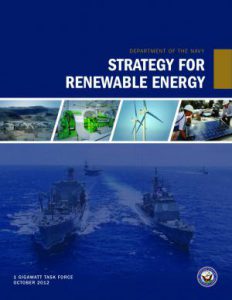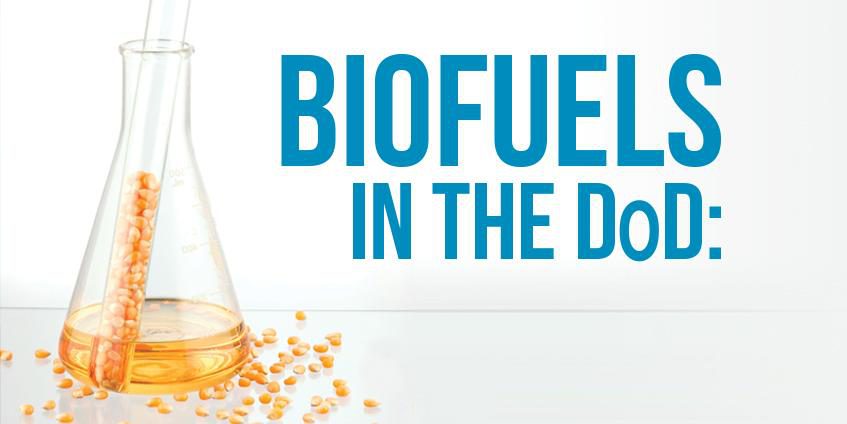The growing concern over U.S. energy security has prompted a number of Government initiatives intended to reduce the nation’s dependence on fossil fuels. Regardless of one’s stance on the scientific feasibility of using biofuels as an economical alternative to traditional petroleum-based fuels, the Navy’s ambitious goals to power the Great Green Fleet carrier strike group on a biodiesel-petroleum blend require an analysis of all potential effects on the system’s operation. This article identifies specifics of the Navy’s plan, as well as noted effects and challenges associated with the use of biodiesel, including those impacting the reliability, availability, and maintainability (RAM) of the system.
Refueling the DoD
U.S. dependency on fossil fuels, as well as the subsequent vulnerability to the effects of geopolitical conflicts on the supply of foreign oil, has raised serious questions and concerns regarding the nation’s energy security. These concerns have led to an increased interest in, and demand for, energy produced by/from renewable sources. The U.S. Government’s support of these efforts is widely publicized and includes examples such as tax incentives for those who own/operate renewable-energy systems (to offset the initial investment costs), as well as funding for universities, manufacturers, and consortiums that research and develop renewable-energy technology and equipment. While this type of support is invaluable to the growth of this technology, it is only one part of the Government’s broader approach to a cleaner, more secure energy strategy.
As the nation’s largest energy consumer, the U.S. Government not only is a major contributor to our energy dependency but is also at high risk should the availability of a particular source become compromised. More specifically, according to the Navy’s “Strategy for Renewable Energy” [1] (shown in Figure 1), the Department of Defense (DoD) accounts for 80% of the Federal Government’s energy consumption and is believed to be the largest organizational user of petroleum in the world [2]. This incredible demand reflects the DoD’s overwhelming dependency on fossil fuels and subsequent vulnerability to a number of factors that can potentially affect the supply of these resources. Together, these factors have led to increased efforts to implement similar “green” strategies within the DoD as those that are being employed within the private sector and by the general public.

Figure 1: The Navy’s “Strategy for Renewable Energy” (2012).
DoD and Renewables
Over their relatively brief history, energy systems powered by renewable sources have seen limited use within the DoD. Installations that have incorporated alternative-energy technologies have traditionally involved small-scale implementations. Some of the most notable examples include solar panels and wind turbines, which have essentially become the poster children of the green movement. These technologies continue to play a larger role in the nation’s domestic power production and have more recently been used in various capacities to support U.S. military facilities. Applications include anything from small-scale systems employed at remote operating bases to large-scale megawatt systems, such as the turbines in use at the U.S. Naval Base at Guantanamo Bay. As the technology has matured, the size and energy-producing capacity of these systems have increased, and, even more importantly, the system availability has improved. It should be noted, however, that these facilities are usually supported by the electrical grid and, thus, have a redundant power supply (often a carbon-based backup) should the renewable source and/or system become unavailable.
Defense systems (with the exception of nuclear energy systems) are similar in the sense that they have predominantly relied on carbon-based fuels. The critical difference is that most of these systems are petroleum-fueled and do not have the luxury of a redundant power supply. Thus, they have far less tolerance for a loss of power from a renewable source.
The aforementioned improvements to solar and wind energy systems are the result of the successive advances over the course of the technologies’ history, as well as the significantly renewed interest and demand over the past decade. Though vegetable oils were used to power diesel engines as early as 1893 [3], the science involved in the large-scale production of petroleum alternatives is not nearly that mature. Nonetheless, the nation’s growing reliance on foreign oil suppliers is such that petroleum-based products have become one of the primary targets for renewable, environmentally friendly replacements. This fact is reflected in some of the more recent policies adopted by the DoD.
One specific example of a green DoD initiative is the strategy outlined by the Secretary of the Navy, which set the following goals [1]:
- By 2020, 50% of the total Department of the Navy (DoN) energy consumption will come from alternative sources.
- By 2020, the DoN will produce at least 50% of shore-based energy requirements from alternative sources; 50% of DoN installations will be net-zero.
- By 2015, the DoN will reduce petroleum use in the commercial vehicle fleet by 50%.
- By 2012, the DoN will demonstrate a Green Strike Group in local operations and will sail it by 2016.
- Evaluation of energy factors will be mandatory when awarding contracts for systems and buildings.
This plan represents a considerable undertaking by the Navy because it not only is the DoD’s most ambitious energy strategy to date but it also addresses a broad range of energy-producing alternatives.
Renewable Petroleum Alternatives
A key element of the Navy’s strategy is the introduction of biofuels as an alternative means to power the various Defense systems within the fleet. Biofuels are alternative fuels produced from biomass. The two most popular biofuels are ethanol, which is commonly blended with gasoline, and biodiesel, which has the greatest potential for DoD applications. Biodiesel, also known as fatty acid methyl ester (FAME), is produced through a transesterification process of one of many different feedstocks. The byproduct is a nontoxic, renewable fuel that is capable of powering diesel engines.
These advantages make biodiesel an attractive candidate for the Navy’s Renewable Energy Strategy, particularly because of the vast quantities of jet fuel and maritime diesel that are used to fuel the Navy’s expansive fleet of aircraft and marine vessels. In fact, one of the first steps in the implementation of the Navy’s strategy involves the aforementioned Great Green Fleet, a Carrier Strike Group fueled by nuclear power and biofuel blends (50/50 biodiesel and petroleum-based marine diesel or aviation fuel). In anticipation of its scheduled deployment in 2016, the fleet constructed a demonstration at the 2012 Rim of the Pacific (RIMPAC) exercise (shown in Figure 2), successfully evaluating the performance of “drop-in” replacement biofuel blends with all systems performing at full capacity.

Figure 2: The USS Princeton Participating in the Great Green Fleet Demonstration at the RIMPAC 2012 Exercise. [4]
An expansion of this program, as a result of the renewable goals and the success of this initial evaluation, could represent a considerable reduction in the Navy’s demand for petroleum. This potential reduction is further supported by the recent Defense Logistics Agency (DLA) solicitation to companies capable of supplying 37 million gallons of drop-in biofuels as part of the Bulk Fuel requirement for DLA Energy’s customers located in the Inland/East/Gulf Coast regions of the United States [5].
Admittedly, some experts continue to question the scientific feasibility of using biofuels as an economical alternative to traditional petroleum-based fuels, as well as the true environmental impact tied to the production of biofuels. The Navy’s plan nonetheless indicates a clear intention to move forward with these renewable alternatives. As such, it is important to consider all potential effects on the systems’ operations, especially when considering the importance of their mission.
Biodiesel
One of the key advantages of using biodiesel is that it can be produced from a diverse collection of oils and animal fats, including waste oil and both edible and nonedible vegetable oils. This variety of biodiesel feedstocks, which can be found all over the world, helps to mitigate issues with the availability of raw materials. More importantly, the variety provides for a number of options that can help to minimize production costs, as well as the potential impact on a nation’s food supply, by targeting nonedible biomass, feedstocks that require the least agricultural inputs (i.e., have the smallest environmental impact), and/or plants that can thrive in environments otherwise unusable for (consumable) agricultural farming. However, feasibility studies must also consider the feedstock’s effect on certain biodiesel properties, including those that affect engine performance, in addition to the aforementioned factors.
The main advantage of biodiesel is its ability to be used as a replacement for petroleum diesel (petrodiesel) without engine modifications as a result of the fuels’ similarities in physical properties (e.g., cetane number). Biodiesel may also be blended with conventional diesel in varying proportions. For example, the biofuels sought in the aforementioned DLA solicitation could be blended in a range of 10 to 50% with conventional petroleum products.
While sharing similar material properties with conventional diesel, biodiesel has the advantage of being nontoxic. Furthermore, biodiesel emits fewer pollutants into the environment, with significant reductions in unburned hydrocarbons, carbon monoxide (CO), and particulate matter emissions (though it does emit a greater quantity of nitrogen oxides [NOx]) [6]. Traditionally, marine diesel has been a lower-quality bunker oil fuel with high levels of pollutants (e.g., sulfur). With pure biodiesel, sulfates are essentially eliminated, while biofuel blends also reap similar benefits based on the percentage of biodiesel present.
A number of additional advantages (having a higher lubricity, being biodegradable and safer to handle, etc.) are mentioned in the alternative fuel literature. While important to the conversation, the primary advantages described previously are the main factors supporting the production and use of biodiesel as a viable petroleum alternative.
Biofuel Reliability
As often is the case for new and evolving technologies, there can sometimes be an overemphasis on the positive characteristics of biofuels and biodiesel (such as those noted previously), while the potential shortfalls can be overlooked. From a reliability perspective, flaws and vulnerabilities are incredibly important to the task of predicting and/or identifying possible causes of failure, such that they can be mitigated and/or corrected to prevent future failures from occurring. Along those lines, we must evaluate the impact that these alternative fuels, specifically biodiesel, can have on engine performance, longevity, and maintainability.
Though similar enough to be used in the same diesel engine, the properties that separate biodiesel from its petroleum-based counterpart are responsible for both the aforementioned advantages and other unique characteristics that would be considered disadvantages. One example is the different behavior that is exhibited under colder temperatures. Petrodiesel typically starts to freeze or “gel” at temperatures well below freezing, while similar effects on biodiesel are observed at much warmer temperatures. In fact, biodiesel’s cloud point, a cold weather property that represents the temperature at which crystals begin to form, can be more than 20° F higher than that of petroleum diesel [7]. Below these temperatures, the continued crystal growth can eventually plug the system’s fuel filter and ultimately prevent fuel from reaching the engine. Such events are a serious threat to the operational availability of a Defense system and, worse yet, a possible cause for engine damage. The significant difference in cold weather performance generally necessitates that a biodiesel blend (e.g., B20 – 20% biodiesel, 80% petrodiesel) be used to limit the temperature increase for these cold weather properties. For more extreme temperatures (e.g., below -20° F), special low-temperature diesel fuels and/or flow additives may be required to prevent the possibility of gelling and any subsequent engine damage.
Biodiesel’s unique properties are also responsible for a number of material compatibility issues that complicate the use of this renewable alternative. These incompatibilities are especially important because some of the materials are commonly used in fuel storage and handling systems. Elastomers and rubbers commonly used in seals, hoses, and gaskets are susceptible to degradation from extended contact with biodiesel, with effects ranging from a general softening to complete failure. The broken-down material can clog filters and potentially ruin fuel pumps; or, in more extreme cases, a failed hose could leak fuel onto a hot engine. Use of natural rubber, buna-N, nitrile, and polypropylene should be avoided for systems operating with biodiesel, although many of these materials have been, or are in the process of being, phased out of use.
Compatibility issues also extend to copper-containing metals, such as brass and bronze, as well as lead, tin, and zinc galvanized surfaces, which can also be found in fuel storage systems. The reaction between these materials and the chemical compounds in biodiesel not only introduces sediments into the fuel supply but can also cause the storage tank to corrode. Another common cause of clogs in the fuel system results from biodiesel acting as a solvent, allowing other substances to dissolve into solution. Though seemingly unimportant, biodiesel will often clean out deposits left behind from the use of petrodiesel, eventually clogging the system when the sediments reach the fuel filters. For this reason, thorough fuel system cleaning and regular inspection of fuel filters are recommended when switching to a biodiesel fuel supply.
Cold-weather performance and clogging of the fuel lines, filters, and injectors are two of the most commonly cited issues with regard to biodiesel-powered systems. The noted disadvantages are most severe for pure biodiesel (B100) and tend to be less severe with a growing percentage of petrodiesel in a blended fuel. In fact, the most common blend used for road vehicles in the United States is B20, which satisfies the minimum blend percentage for renewable/environmental requirements while also limiting the impact of the negative effects of biodiesel’s use. The Navy’s plan indicates that it intends to use a 50/50 blend (B50), which will likely exhibit more of biodiesels’ characteristic behavior. A B100 (100% biodiesel) standalone drop-in replacement typically requires engine modifications.
An anticipated challenge to the Navy’s plan involves the storage and/or availability of biodiesel or biodiesel blends. With a global operation, procuring the necessary resources, including fuel, may be difficult. While biodiesel can be produced from a number of previously discussed feedstocks, the biomass used in the production of the fuel affects its relevant properties. Furthermore, there is no international marine-grade biodiesel standard, with the current U.S. and European standards (ASTM D6751 and EN 14214, respectively) relating to road vehicles and land-based systems [8]. Storage of biodiesel also presents a challenge, as noted in the discussion of compatibility issues with common storage materials. Some biodiesels will also break down when stored for extended periods of time as a result of reacting with atmospheric air in high temperatures. Additional additives are recommended to prevent or limit oxidation degradation of the fuel and inhibit corrosion, both in the engine and the fuel-handling system.
Biofuel R&D
The renewed interest in renewable energy has also led to the recent release of a number of new policies and initiatives from various Government agencies. While some include pilot study evaluations, such as the Navy’s Great Green Fleet Carrier Strike Group, others have more of a research and development (R&D)-based focus. One of the leading agencies for such activities is the National Renewable Energy Laboratory (NREL), which the Department of Energy (DoE) selected to co-lead the National Advanced Biofuels Consortium (NABC). This national program is tasked with the development of advanced biofuels that follow a sustainable, cost-effective production process while maximizing the use of existing refining and distribution infrastructure.
While biofuels have been proven capable of powering automobiles and various internal combustion engines, the extent of their use and acceptance as a viable petroleum replacement will ultimately be determined by a number of relevant factors, such as cost, availability, and performance. In other words, demonstrating that engines can run on this fuel is one part; the second is to ensure that a petroleum alternative does not compromise performance or introduce a new set of problems (i.e., trading one problem for another). Unfortunately, observations from early biofuel (biodiesel in particular) implementations have suggested that there are issues with which to contend (identified in the previous section) based on the unique biofuel properties. Mitigation of these issues continues to be an important goal of ongoing research efforts.
While not alone in this effort, NREL (as its name suggests) is one of the leading laboratories for the R&D of renewable energy technology. NREL’s efforts extend across a myriad of alternative-energy technologies, including wind, solar, geothermal, hydropower, and hydrogen fuel, as well as across materials and computational and structural engineering disciplines for energy efficiency. With respect to biofuels, research activities address a wide range of topics, from performance and emissions to storage and stability. Certain efforts involve the testing and evaluation of biofuels to quantify specific performance metrics. The results of these analyses are used to develop mitigating strategies for the aforementioned challenges of biofuel use, through materials selection considerations and the biochemistry investigations for the development of fuel additives and stabilizers.
In addition, NREL’s biofuel research extends well beyond biodiesel and ethanol, the two most well-known renewables for diesel and spark-ignited engines. The organization has several forward-looking research efforts in a variety of fuel types (cellulose-derived oxygenates, hydroisomerized fats and oils, butanol and long-chain alcohols, etc.). These efforts are considering a number of potential alternatives to traditional petroleum-based products. Much of this research involves biomass characterization. The sustainability of these alternatives is heavily dependent on both their economic and environmental costs. Accordingly, it is essential to develop an understanding of the different biomass properties to determine the environmental requirements and the necessary processing steps and byproducts, as well as the energy and quality-related properties (e.g., cetane number and energy content) of the resultant biofuel. Ultimately, these are some of the most important factors for long-term sustainability.
While the investigations into a number of different biofuel feedstocks continue, one category of biomass that has gained popularity for its numerous advantages is algae biofuels [10]. Algae (plural for alga) biofuels have a significantly greater yield and, in addition to the high energy and lipid content (used in biodiesel), also produce byproducts that can be used as fertilizers and ethanol feedstocks. Typically cultivated in large man-made ponds (as illustrated in Figure 3) or commercialized photobioreactors, algae biofuels are not competitive with agriculture and require limited input (water, sunlight, and CO2). The challenge, however, lies in the costs associated with the commercialization of algae production. NREL is currently engaged in a number of R&D efforts to overcome these challenges, including the following:

Figure 3: Artist Rendition of Algae Cultivation Ponds. Photo Credit: Pacific Northwest National Laboratory [9].
- The development of metabolic models and related software tools to model and optimize algae behavior based on parameter manipulation.
- The isolation, characterization, and assessment of scale-up potential of microalgae from samples taken from a variety of northern marine and freshwater habitats.
- The identification and development of microalgal strains that can be cost-effectively harvested and processed into biofuels.
- The investigation of the biochemical conversion of algae into biofuels and the analysis of the physical chemistry properties of subsequent algae fuels.
Partnered with a number of like-minded organizations, NREL and its continued R&D efforts are vital to the economic feasibility of biofuels as a replacement to petroleum products.
Conclusions
The use of renewable alternatives provides a promising outlook for the nation’s future and security, especially as the country continues to work to wean itself from its long-time dependency on fossil fuels. However, the implementation of this continuously emerging technology will require researchers and developers to consider all possible effects and challenges on system operations so as not to overlook potentially critical flaws that may have a considerable impact on the reliability, availability, and/or maintainability of the systems being considered.
References:
- Department of the Navy 1 Gigawatt Task Force. “Strategy for Renewable Energy.” October 2012.
- Schwartz, M., K. Blakely, and R. O’Rourke. “Department of Defense Energy Initiatives.” Congressional Research Service, 2012.
- Mofijur, M., et al. “Effect of Biodiesel from Various Feedstocks on Combustion Characteristics, Engine Durability and Materials Compatibility: A Review.” Renewable and Sustainable Energy Reviews, 2013.
- White House Council on Environmental Quality. “Advancing National Security Through Energy Security.” http://www.whitehouse.gov/blog/2012/07/27/advancing-national-security-th…, accessed October 2014.
- Defense Logistics Agency. “Sources Sought Notice for Inland/East/Gulf Coast Region,” Solicitation Number SP060014R0061, https://www.fbo.gov/index?s=opportunity&mode=form&id=7ccccd31d8003706646…, 16 July 2014.
- Biodiesel.org. “Biodiesel Emissions.” Fact Sheet, http://www.biodiesel.org/docs/ffs-basics/emissions-fact-sheet.pdf?sfvrsn=4, accessed October 2014.
- National Renewable Energy Laboratory. Biodiesel Handling and Use Guide. 4th edition, 2009.
- Lin, C.-Y. “Strategies for Promoting Biodiesel Use in Marine Vessels.” In Marine Policy, Elsevier, 2013.
- Office of Energy Efficiency & Renewable Energy. http://www.energy.gov/eere/bioenergy/production, accessed October 2014.
- National Renewable Energy Laboratory. “Biomass Research: Microalgal Biofuels Projects.” http://www.nrel.gov/biomass/proj_microalgal_biofuels.html, October 2014.


